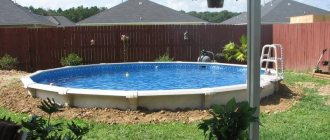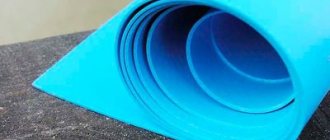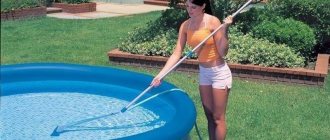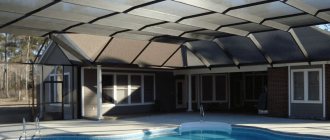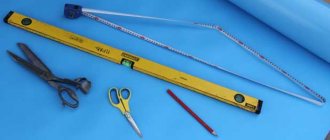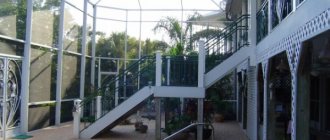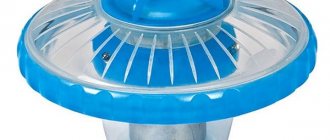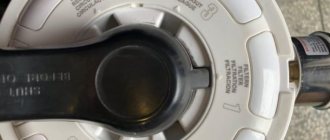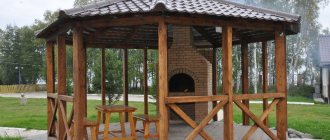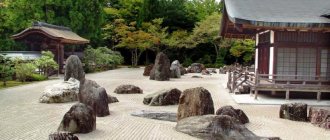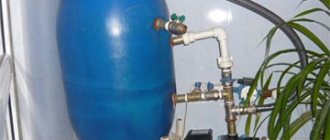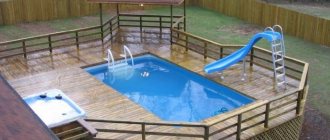Types of pools
Private and public swimming pools are:
- rectangular, round, asymmetrical;
- buried in the ground completely or partially, not buried in the ground, located on the surface;
- stationary or collapsible;
- outdoors or under a roof.
Bowls are filled in different ways. They can be bulk, recirculating or flow-through. Water can be supplied without heating or with heating. All operating conditions are taken into account when choosing options for constructing a pool. Nowadays pools are built from concrete, composite materials, and polypropylene. To decorate the internal surface and waterproofing, PVC films, membranes, and sprayed materials are used.
Position relative to ground level
Reservoirs can be buried in the ground, providing for liquid supply and drainage. They can be ceramic, fiberglass, brick in structure.
Temporary devices are left on the surface, collected and stored in the utility room at the end of the season. Externally, they cannot be called very aesthetic, with the exception of the glass original design, which has a luxurious image.
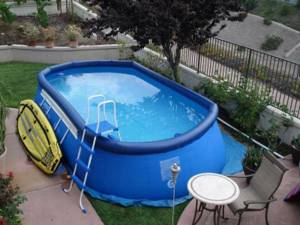
The simplest version is an impressive barrel near the bathhouse. The location on the podium looks great.
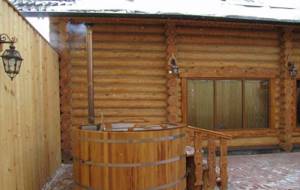
Preparatory work
Swimming pools are open and closed. Open bowls are built less frequently, since their use is limited to the warm season. Pools under the roof are installed in an existing permanent building, but more often a separate room is built for them, in which it is necessary to provide ventilation, air flow and dehumidification to prevent the appearance of mold.
Before the construction of any in-ground pool, soil analysis and geotechnical surveys are carried out. If their results reveal that the grant waters are close and the soil is prone to heaving, then in some particularly difficult cases the construction of a pool will have to be abandoned. Instead, you can install a shallow bowl on the surface. Silty soils are not suitable for construction. You can build on everything else, but some soils require a special approach when arranging drainage, waterproofing and choosing materials for construction.
Project development
Compact pools for summer cottages and complex bowls for water parks differ not only in appearance. For everyone, it is necessary to create their own project, which takes into account the terrain, dimensions and design features, installation of the necessary equipment and installation of technical systems. The calculations take into account that for each person in the water, at least five cubic meters are needed. The depth can be constant or variable. The most comfortable depth for a private pool is considered to be 1.5 meters deep, but it can be different - either greater or less. If you plan to install even a small springboard, the depth of the bowl should exceed 2.5 meters.
Criteria for choosing an inflatable option
It's just a rubber reservoir that can be filled with water at will. It differs in size and ability to be transported. There are different variations of an inflatable pool for a summer residence: medium-sized outdoor ones, children’s “paddling pools,” and large ones. “Splash pools” are very cheap, but they cannot boast of their dimensions.
They also differ in appearance. You can often find a round version, but square, rectangular and oval ones are less common . Inflatable installations have many qualities, both positive and negative. The advantages include:
- possibility of transportation, compact dimensions;
- affordability of prices;
- no need for regular maintenance.
Any type of pool can have its drawbacks. In this case, the disadvantages include:
- low reliability - such a pool is easy to damage;
- appearance - the rubber structure does not look very respectable when compared with frame analogues;
- dependence on air - it will have to be inflated before each use.
Choosing an inflatable pool allows you not to worry about free space and regular maintenance. But low reliability does not suit everyone. This is simply the most budget option for summer residents and small areas .
Pit preparation
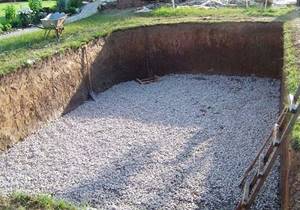
It should have enough space for a pillow, reinforced walls and bottom of the frame, pipe laying, and embedded elements. For a concrete bowl, the wall thickness cannot be less than 20 cm; a sand cushion requires an additional 15 - 25 cm. Composite bowls require less space, however, even when using them, the pit must be larger on average by 50 centimeters in each direction. A base for the bowl is placed in a dug pit. It consists of the following layers:
- crushed stone - at least 200 mm;
- sand - at least 100 mm;
- the first layer of “lean” concrete” - no less than 100 mm;
- waterproofing - membrane materials are well suited for this.
Waterproofing is also done on the walls of the future pool. This is necessary to prevent the penetration of groundwater from all sides. In some cases, a layer of thermal insulation is made from polystyrene foam.
Then, in a prepared pit with a substrate and layers of hydro- and thermal insulation, a bowl is mounted. It can be traditional concrete, as well as from modern composite materials - fiberglass, polypropylene.
Construction of a pit reservoir
Self-improvement will require clearing the selected area. After this, a pool design is prepared. This task can be done by a professional who can accurately calculate the degree of inclination and other details. An incorrect calculation can cause a collapse.
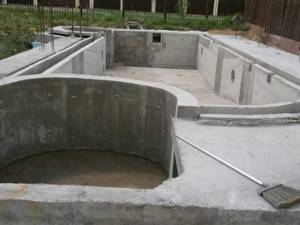
They dig a hole that is half a meter larger than the size of the bowl. The bottom should be leveled and compacted, then laying a 30 cm drainage layer, including sand and crushed stone.
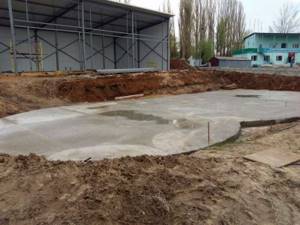
The time has come to lay waterproofing; it can be done with roofing material protruding beyond the bottom edge. Having laid the reinforced frame, concrete is poured. After it hardens, formwork is installed - these are wooden boards or plywood.
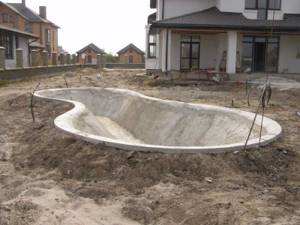
After wetting the bottom, pour the solution into the walls layer by layer. Having passed the first stage, the reinforcing mesh is mounted. After drying, the formwork parts are removed. To make the coating even, use a grinding machine.
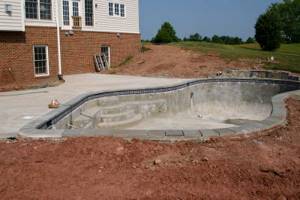
Construction of a concrete pool
The most common and reliable option is a concrete bowl. It is also the most expensive and time-consuming way to build a pool.
Concrete structures have a number of advantages:
- construction on almost any soil and site with any relief;
- the ability to build a bowl of any shape and size;
- long service life;
- the ability to use any embedded elements, pipelines;
- various design options - tiles, mosaics, films, etc.
In addition, with the correct selection of concrete and compliance with the technology, the frame itself has good waterproofing and thermal insulation properties.
Large swimming pools, for example, for hotels, water parks, and recreation centers, are built from reinforced concrete. To do this, formwork with reinforcement is installed in a prepared pit with waterproofing. At the same stage, all embedded elements, pipelines, channels for wiring and equipment are installed.
Concrete is poured in one or two stages, using durable and frost-resistant grades of concrete. Vibrators are used to remove air from concrete and compact it as much as possible. This is necessary to prevent the appearance of microcracks and voids in the bowl through which groundwater could leak. The walls of the bowl must be at least 20 cm. It takes at least 28 days for the concrete to set and completely harden. Violation of deadlines and technology lead to the fact that the bowl can crack, crumble, or leak water.
Design of a concrete pool bowl
After the concrete has hardened, the formwork is removed, the surface of the bowl is leveled, sanded, and plastered. Then another layer of waterproofing is done. Modern PVC membranes are perfect for this. They not only reliably protect against moisture penetration, but can also act as a finishing coating for the pool bowl. These membranes look like film and are available in different colors. They have good operational and technical characteristics - they are durable, elastic, resistant to damage by microorganisms.
To decorate the bowl, ceramic tiles, glass or ceramic mosaics, as well as decorative tiles made of polymer materials are used. The traditional option for baths and saunas is to decorate them with mosaics in blue, light blue, and turquoise shades. For sports facilities or swimming pools for recreation centers, neutral-colored medium format tiles are used.
Another finishing option is plastering with hydrophobic compounds over a mesh. This option allows you to get a coating that is uniform in texture and color, but it will have a significant disadvantage - a short service life. Under certain conditions of use, the plaster will simply begin to deteriorate. You can use plaster based on epoxy resins, it is a little more durable.
An expensive and even luxurious option is finishing the bowl with marble and natural stone. When choosing this type of finishing, much attention is paid to protecting the joints of finishing materials.
Selection rules
In order for the purchased structure to serve for a long time without complaints, you should adhere to the general recommendations. They are very simple:
- The outdoor structure should be placed in a place isolated from the sun and wind, away from trees. There should be a place for equipment and water nearby.
- On average, per one bathing person there are two cubic meters of water, if the depth is up to a meter, with a depth of up to one and a half meters - up to 2.5 cubic meters, up to two - 3.5, more than two meters - 4.
- The maximum depth for children should be thirty centimeters, for learning to swim it should be 1.3 meters, for teenagers - no more than 1.4 meters. The universal depth is considered to be 2.2 meters.
- It is better to make a bottom with gradually increasing depth.
- Fiberglass options are suitable for areas with high groundwater levels.
- Prefabricated devices are chosen for low budgets: prefabricated panels, steel, polypropylene.
- Frame and inflatable models are suitable for a stationary look. For a long service life, a stationary concrete type is selected.
Among the pools listed, it is impossible to single out one favorite. They are simply designed for different operating conditions and site sizes. The selection of an inexpensive design for a summer residence is carried out in determining the appropriate option according to personal preferences. The advantages and disadvantages of each model are taken into account.
Construction of composite pools
Instead of a traditional concrete bowl, you can use a ready-made bathtub made from modern composite materials. The advantages of this option are:
- there is no need for multi-stage waterproofing;
- reduced installation time;
- strength of the internal coating;
- ease of maintenance.
The disadvantages include small size and the need to choose from a limited number of shapes. The finished composite bowl is relatively light; some types of soil can push it out, so it requires additional fastening in the pit. In addition, it is difficult to build a composite pool in an already used capital building, since the finished bowl simply cannot be brought into the building. Most often, extensions are made for such pools to a cottage, country house, bathhouse, or a separate structure is built.
Country deep option
This is essentially a hole dug in the ground and lined with concrete. You can buy a ready-made bowl, for which you just need to make a recess of a certain size. Facing materials are applied to the concrete on top to make the structure look more attractive and pleasant to the touch.
Despite approximately the same dimensions of the frame and depth versions, the latter will cost significantly more. But this price is directly related to the benefits. These include:
- monumentality - such a pool is difficult to damage, the base is located underground, the outer sides are reinforced;
- medium size - it takes up less space, since it is installed underground, there are no bulges at the top;
- appearance - facing materials add attractiveness to the entire structure. In shape, it sometimes differs significantly from classical geometric figures; you can find a figure-eight or washcloth-shaped version, when closer to the center two circles at the edges narrow;
- additional functions - heating, lighting, constant water circulation, hydromassage can be installed, all communications will be hidden underground.
The only disadvantages include the need for regular maintenance; in addition, installing a deep pool is not a cheap pleasure. Especially if you need to install a large structure with additional capabilities. It is unlikely that you will be able to do the installation yourself. Dismantling is possible during certain construction works. Consequently, such a structure is installed for a long time; it cannot be moved in any way, unlike the other two structures.
To save money, you can buy a ready-made small bowl. Its price is quite reasonable. If you wish, you can even install it yourself.
Construction of polypropylene swimming pools
The pool bowl for private houses and cottages is assembled from polypropylene sheets welded together. In essence, the construction of a polypropylene pool is similar to the construction of a concrete bowl, but plastic formwork is used instead of wooden formwork. It also acts as the outer covering of the pool and its waterproofing.
To construct such a bowl, a pit with a concrete base and waterproofing is prepared. A pre-prepared polypropylene bowl is installed in it. It can be manufactured according to the design at the factory or assembled on site. Between the walls of the polypropylene bowl and the pit, layers of concrete with reinforcement are poured for greater strength of the entire structure, expanded clay and sand are poured.
The advantages of a polypropylene pool over a concrete one are slightly reduced construction time and the absence of the need to decorate the inner surface of the bowl. In addition, it is a material with good waterproofing properties. It is not susceptible to mold and fungi. Any additional equipment can be installed in a polypropylene pool. By welding at the installation site, you can make a bowl of any shape and size. At the same time, you can build a swimming pool either outdoors or in a permanent or prefabricated building specially designated for it.
Construction of a polypropylene pool is somewhat cheaper than a concrete one, however, it cannot be called cheap.
Pros and cons of frame models
When choosing a pool for a dacha, the frame option is often considered. It is installed, like an inflatable one, on the ground. This is, in fact, a fixed pit with water. It is made from PVC plastic, which is safe for the human body.
Their shape is often produced rounded with flat edges. Rectangular and square variations are rare. If the frame is made of plastic, then it can be of different colors; if it is made of metal, then there are not so many color options.
When choosing an inexpensive pool, you need to focus on its advantages and disadvantages. The advantages include:
- average reliability - light punctures do not lead to failure;
- ease of use - just fill the pit with water from a hose;
- neat appearance - a variety of colors will help you choose the option specifically for your summer cottage, and it will look better than an inflatable one.
For many, the disadvantages of frame models play a decisive role in their choice. These include:
- the need for frequent maintenance, you will have to regularly wash the plastic side of the pool from the inside;
- the water needs to be changed often, otherwise it will bloom;
- if you do not cover the pool, it will be exposed to external factors;
- large dimensions, it takes up a lot of space and is very noticeable, as it stands on the ground;
- the frame structure is more difficult to disassemble and move to the desired location.
The cost of this design is higher than that of the inflatable one, but lower than that of the deep version. This is a good inexpensive option for medium-sized plots. In a small area it will take up too much space and attract attention.
Prefabricated frame pools
The simplest option for a summer house or country house. It does not require a foundation pit or serious preparatory work. To install such a pool, you only need a flat area of sufficient size. The bowl is assembled and started in a few hours. If it will be used for a long time - for example, throughout the summer - it is advisable to fill the leveled prepared area with sand and lay a layer of insulation on top of it. Then the pool frame is assembled, to which the polymer cover is attached. It can be more or less dense and elastic, depending on the size of the pool. Typically, the volume of such a bowl does not exceed 25 cubic meters, which is quite enough for seasonal use for a family with children or a small company.
The prefabricated structure can also be installed in a prepared pit, and the space between it and the walls of the pit can be filled with a mixture of sand and expanded clay or concreted. This is a budget option designed for a short period of use.
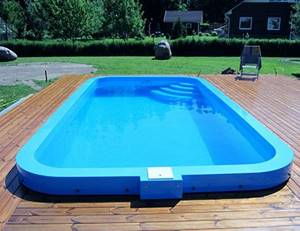
Polypropylene
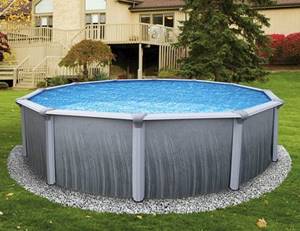
Prefabricated frame
Advantages and disadvantages
To assess the feasibility of purchasing such water structures, it would not hurt the buyer to first get acquainted with the advantages and disadvantages of inflatable models.
Their main advantages are the following:
- Subject to regular maintenance of the product, it is possible to ensure complete safety of bathing water, which cannot always be guaranteed when using natural reservoirs in which the water is not disinfected in any way.
- Reasonable price. If we compare inflatable models with other types of artificial reservoirs of similar bowl volume, then it is the former that will be more affordable.
- Compact dimensions when folded. This greatly simplifies transportation and storage.
- Possibility of repeated movement from any place.
- Minimum requirements for the installation site.
- Simple assembly and installation technology.
But artificial reservoirs also have a number of disadvantages:
- Not all, even very large pools allow you to swim, since most models have a depth of no more than 1.3 m.
- In the process of servicing large volumes, it is necessary to solve the problem of recycling used water, and this can create certain difficulties, since its weight can reach 15 tons.
- The water in the bowl does not remain fresh and suitable for bathing for long. Microorganisms multiply very quickly in it. This forces it to be changed several times a day or cleaned with chemical additives.
- The side pipes have to be constantly pumped up due to air leakage through the valves.
- Ultraviolet rays affecting the walls gradually deteriorate the characteristics of the pool.
- Although inflatable pools are considered quite durable structures due to their multi-layer structure, they can be easily damaged by sharp objects.
Pool equipment
Whatever material the bowl is made of, the convenience of using the pool depends not only and not so much on this. It is important to equip the pool so that it is warm, safe and comfortable.
For this purpose, during construction it is planned to install a variety of equipment:
- filters for water;
- pumps;
- aeration systems;
- countercurrents;
- heaters;
- hydromassage devices;
- backlight
Water filtration is a necessary condition for the operation of any pool - private and especially public. There are two types of filters - skimmer and overflow. For home use, a skimmer is sufficient, including one installed after the construction of the pool. And for sports pools and water parks, overflow systems are needed. Equipment for them is provided at the construction stage. In this case, it is also necessary to allocate a separate room for the installation of related equipment - filtration pumps, compensation tanks, pumps. The construction of such a station must be carried out by professionals with conditions for proper cleaning.
Counterflow systems and hydromassage nozzles are installed in bowls for water parks, baths and saunas, and spas. They can also be installed in a regular pool for a private home, cottage, or cottage.
Of course, you can’t do in any swimming pool without handrails and stairs. Today it is possible to order the construction of a swimming pool of any complexity, equipped with the most modern equipment. Professionals will build a turnkey pool, install all the necessary equipment, and will be able to service the pool on a regular basis, checking all its characteristics. Modern swimming pools are designed for a long service life, which is made possible by the use of reliable construction, insulation and finishing materials. In a period from several days to two months, you can build a swimming pool for any purpose - sports, recreational or just for leisure.
We are building a swimming pool on our site
Having your own swimming pool is becoming increasingly popular in our country. Having your own pool certainly adds respectability to your home and increases its value. Whether you use it for relaxation, therapy, as a gym, or simply as a place to have fun, a swimming pool can bring endless joy to you and your family.
This is a serious decision, but by turning to the services of professionals, you can be sure that you will receive a quality product that will fully meet your current and future needs.
